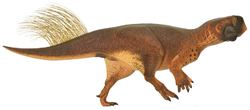| Bainoceratops Temporal range: Late Cretaceous, | |
|---|---|
 | |
| Speculative life restoration | |
| Scientific classification | |
| Kingdom: | Animalia |
| Phylum: | Chordata |
| Class: | Reptilia |
| Clade: | Dinosauria |
| Clade: | † Ornithischia |
| Clade: | † Ceratopsia |
| Clade: | † Euceratopsia |
| Genus: | † Bainoceratops Tereshchenko & Afliafanov, 2003 |
| Species: | †B. efremovi |
| Binomial name | |
| †Bainoceratops efremovi Tereshchenko & Aflifanov, 2003 | |
Bainoceratops (meaning "mountain horned face", after the type locality, Bayn Dzak) is a genus of ceratopsian dinosaur from the late Campanian in the Late Cretaceous. The type species is B. efremovi. [1] Its fossils were found in southern Mongolia in the Djadochta Formation.



